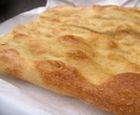|
Afghan Side Afghan Flatbread Noni, Afghan's traditional bread, is similar to India's Naan. Served with most meals, it's torn into pieces and used to scoop up food.
Yeast: mix yeast and sugar with 1/2 C warm water. Let stand for 10 minutes until it begins to fizz and froth. Sprinkle top with 1/2 tsp. flour and let stand 5 more minutes. It will rise and froth quickly. Dough: In a large mixing bowl, add flour and salt. Make a well in the center and add oil and yeast mixture. Stir this in, and slowly add remaining water, in small amounts, till you have a soft, moist dough. Knead for 5 minutes and place dough back in bowl, covered with a towel. Set in a warm spot to rise for 1 1/2 hours. Roll dough: Preheat oven to 350. After 1 1/2 hours, punch the dough down and divide it into 8 equal portions. Roll each into a ball, then flatten each ball into 6-7" oval, about 1/2" thick. Brush each piece with egg yolk mixture and sprinkle with seeds. Bake: Place on an ungreased baking sheet and bake 20-25 minutes till golden brown. Serve immediately or cool and serve as you would pita bread. Serve with Spinach & Yogurt Dip or with any other Afghan dish. * Traditionally, black cumin seeds are used, but they may be hard to find. |
Tips & Glossary Afghan food is similar to the Middle East's and India's, using use many of the same spices. But Afghan cuisine is milder and lighter than its Indian cousin. Many of the ingredients used in Afghan dishes probably aren’t in your spice shelf, but you'll find them at Asian or Mid-Eastern shops. • Deep Frying: be sure oil is hot; otherwise food will be soggy and greasy. Use a deep-fry thermometer to achieve the called-for temperature. When cool, oil can be strained, refrigerated, and re-used. • Basmati Rice: literally “Queen of fragrance." This rice, cultivated in India, is known for its delicate flavor and fragrance. • Besan: also known as “gram flour,” made of ground chana dal, like chickpeas, only smaller and lighter in color. • Cardamom: related to the ginger family. Pods (green, brown, or black) are the best way to store cardamom. But high-quality ground is also available. A rule of thumb: 10 pods = 1 1/2 tsp. ground. • Coriander: aka cilantro, Chinese, or Mexican parsley. Both fresh leaves and dried ground seeds are used in Afghan, Mid-East, Asian, Indian, and Mexican cuisines. • Garam Masala: literally, “hot spice,” usually a mixture of cinnamon, cumin, cloves, nutmeg, and green cardamom seed or black cardamom pods. Because it loses its flavor quickly try to buy it with whole spices and grind it when you need it. • Ghee: clarified butter. Melt 1 lb. unsalted butter over low heat for 20 minutes (careful not to burn), remove from heat and skim away solids. Strain through cheesecloth into a separate container and keep…forever. It doesn’t need to be refrigerated. If you buy commercial ghee, make sure it comes from real butter, not hydrogenated oils. • Rosewater: distilled from rose petals and used to flavor Mid-Eastern and Asian cooking. You can make your own—but why? Buy it. • Turmeric: a deep yellow ground spice, member of the ginger family, used in curries. It has a marvelous earthy, peppery flavor.
|
Site by BOOM
![]()
LitLovers © 2024

 Dish
Dish